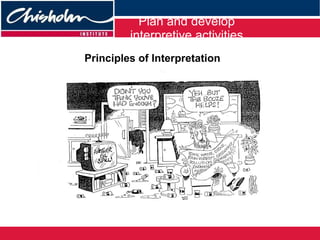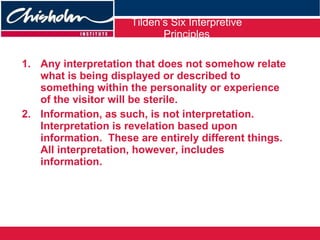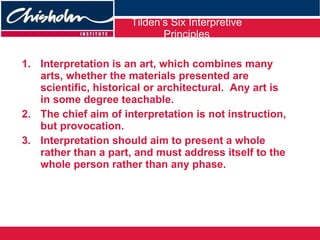- 1. Plan and develop interpretive activities Principles of Interpretation
- 2. Communication Strategies Information/publicity/promotion Advisory service/extension Liaison/consultation Interpretation Community Education Community involvement/public participation
- 3. Relationships
- 4. What is interpretation? A teaching techniques that uses unique methods and involves unique subject matter – natural, cultural, management and recreational resources of a site A service provided by agencies for visitors – one that entertains and conveys the true meaning of the site A management tool , first by using the above two to increase visitor’s appreciation of a site in order to encourage protection of its resources, second by communicating to users goals of the agency which has some management role in the area.
- 5. A Communication Model SENDER (who?) MEDIUM (how?) RECEIVER (to whom?) MESSAGE (what?) FEEDBACK (so what?)
- 6. What type of interpreter are you? Cops – perceive visitor activity as threatening to the local environment; tolerate audience by issuing many rules for visitor behaviour Machines – regurgitate the same performance without modification; no spontaneity, personal input or adaptation to audience variation Know-it-alls – focussed on imparting information to suggest superiority; cannot admit lack of knowledge; prefer to pretend Hosts – offer all clients the opportunity to speak and contribute to discussions; happily take questions; chat and joke; respond to audience needs, even it means deviating from the plan Adapted from Ham (1992:135)
- 7. Interpretation is . . . An educational activity which aims to reveal meanings and relationships through the use of original objects, by first hand experience, and by illustrative media, rather than simply to communicate factual information (Tilden)
- 8. Interpretation is . . . A means of communication ideas and feelings which help people enrich their understanding and appreciation of their world, and their role within it (Interpretation Australia Association)
- 9. Interpretation is . . . The craft of enriching visitor experience; an interactive process involving the visitor, the medium (human or non-human) and the resource (WA Department of Conservation and Land Management)
- 10. Interpretation is . . Interpretation is the act of identifying or transmitting meaning. On the one hand, it comprises the process of working out an understanding of particular phenomena in, for example, the fields of life sciences, material culture or social history. On the other hand, interpretation includes the conceptual and methodological approaches and techniques. (Continued over)
- 11. Interpretation is . . . Heritage interpretation is a process that plans and provides for visitors, potential visitors and the public at large, physical, intellectual and affective access to the cultural and ecological significance of places, objects, natural systems and living things. The appropriate technologies and the responsible stimulation of ideas and opinions, it encourages their protection, preservation and appreciation by and for present and future generations. (Nethery)
- 12. Tilden’s Six Interpretive Principles Any interpretation that does not somehow relate what is being displayed or described to something within the personality or experience of the visitor will be sterile. Information, as such, is not interpretation. Interpretation is revelation based upon information. These are entirely different things. All interpretation, however, includes information.
- 13. Tilden’s Six Interpretive Principles Interpretation is an art, which combines many arts, whether the materials presented are scientific, historical or architectural. Any art is in some degree teachable. The chief aim of interpretation is not instruction, but provocation. Interpretation should aim to present a whole rather than a part, and must address itself to the whole person rather than any phase.
- 14. 6. Interpretation addressed to children should not be a dilution of the presentation to adults, but should follow a fundamentally different approach. To be at its best it will require a separate program.
- 15. Sam Ham’s Interpretive Approach to Communication Interpretation is pleasurable Interpretation is relevant Interpretation is organised Interpretation has a theme
- 16. Needs Pyramid Only when basic needs are met can humans turn to growth needs Self development/fulfillment Ego/self esteem Love/belonging/social interactions Security Safety Air/food/shelter etc
- 17. Percentage of Retention
- 18. How people learn Visual learning Auditory learning Dynamic learning Symbolic/Abstract learning
- 19. Learning Styles
- 20. Interpretive Activity Design Process Identify topic/idea/issue Choose location and audience Prepare outline Determine method of presentation Conduct a dry run Select title and theme/concept Develop measurable objectives Research information to develop story Draft script from outline Liaise with client group
- 21. Themes A theme for your activity must be: Stated in one complete sentence Contain one main idea Reveal the overall purpose of the presentation Stated in an interesting manner.
- 22. Themes Don’t confuse a topic with a theme. While a topic might be “ birds ”, a theme might be “ birds are fascinating creatures because of their special adaptations for flight ”.
- 23. Writing objectives Think about why you are going to conduct an activity and what outcomes you hope to achieve. Be clear and specific. Keep objectives as simple as possible so they are easily understood. Ensure objectives are relevant to your client, location, target audience. Write objectives that can be easily measured. Consider objectives that focus on – knowledge and understanding, skills and abilities for participants to acquire, attitudes and values for participants to appreciate, and action for participants to take.
- 24. Who is my audience? Young Endeavours Jet-a-bouts Guiding Gurus New-age Thoughtfuls Energy Maximisers Armchair Ventureres Ponderers Mad Rappers Itchy Feeters Green Chalkies Vintage Voyagers
- 25. Scripting your presentation Simple language (not jargon) Similes and metaphors Relate or use appropriate analogies Provoke Tease Correct the past Storytelling Triphammer A powerful conclusion (your message)
- 26. Using props and demonstrations Why use a variety of props and demonstrations as interpretive tools? Give a better understanding Get participants up close and involved Hold attentions, encourage questions and get people thinking Show the big picture Show how it is done Show how it works Help explain big words Far more interesting than a lecture Uses the senses
- 27. How to use your props and demonstrations Appropriate Accurate Tasteful Legal Safe Visible Up close Involvement Innovative
- 28. Evaluation Self evaluation Consider feedback during the activity (smiles, questions, responses, participation) Check you achieved your objectives Video and audio tape
- 29. Evaluation Peer evaluation Use an observer to monitor group responses Use a supervisor as assessor Debrief with colleagues Client Feedback Participant survey




























